Menu
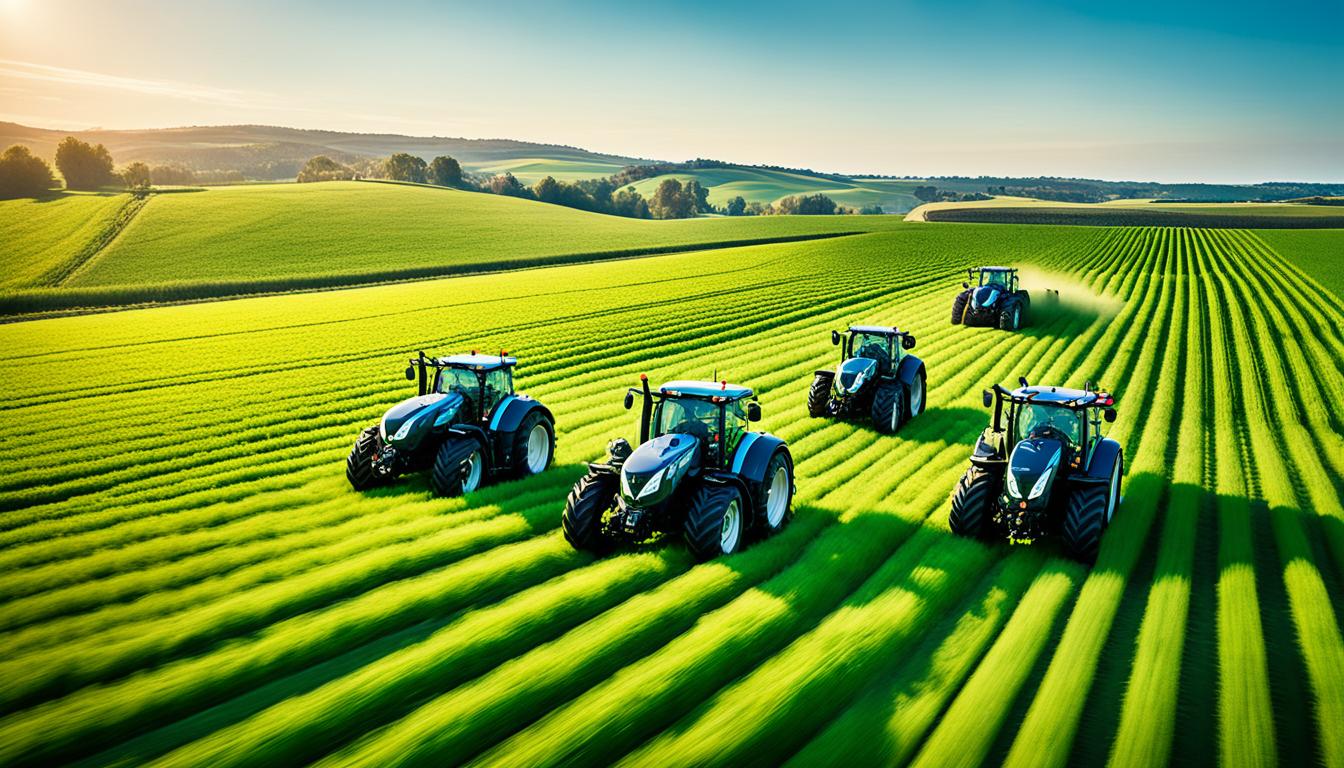
In India, there are more tractors on farms than anywhere else. This shows how much they rely on machines. It’s part of a worldwide trend. Farming is getting more techie everywhere. For example, the U.S. is a leader in using high-tech farming gear. They have autonomous tractors driving by themselves. This is happening a lot in California and Washington.
Autonomous tractors are changing farming for the better. Companies like TYM are leading the charge. Since 2013, they’ve been making self-driving tractors. In 2021, TYM made a tractor that drives itself with record precision in Korea. These machines use GPS and sensors to work smarter and harder. They’re key for farming all the time, especially at planting and harvest times.
Farming is changing thanks to new tech, moving towards eco-friendly ways. Autonomous tractors show this shift, leading to better work on farms. By 2028, the market could grow from $2.4 billion to $7.1 billion. This is largely due to better IoT and navigation tech, making farming more precise and efficient.
In the 1950s, Ford made a step with “The Sniffer,” a start in automation. It was the first try, not a big commercial hit, but it opened the door for future tech. Now, with *AI-powered tractor technology*, farming is getting more high-tech. This is key for meeting the world’s growing food needs. The tractor market should grow by 2025, showing the need for more effective farming tools.
Starting in 2008, Deere and Company improved automation with the ITEC Pro system. It uses satellite tech to help track soil, crop health, and harvest info. This data is crucial for good farm management. Also, using *driverless farming equipment* means doing more work with less people.
Key tech moments in farming include the General Purpose Tractor in 1928, which upped farm production. In 1939, the John Deere Model B brought in electric starts, lights, and more power. Now, *AI-powered tractor technology* is making farming smarter and more sustainable.
The push for eco-friendly farming is spurring on tech developments. Smart greenhouses, automatic sprayers, and *autonomous soil analyzers* are at the forefront. Yet, there’s still a need to help farmers get familiar with these new tools. Using smartphones to help manage and analyse data is a big plus, helping more farmers adopt these new methods and boost production.
With new farming tech, agriculture’s future looks bright. Innovations in robotic and autonomous tech are leading the way in making farming more efficient and eco-friendly.
As technology in farming grows, autonomous tractors stand out. They use AI, robotics, and GPS to change farming for the better. By using these technologies, farmers can do more work. They can work better, too, which is a big deal for farming.
Autonomous tractors work on many farming tasks alone. They can plough, plant seeds, and harvest crops without much help. This means they are very good at working quickly and whenever needed, for as long as necessary.
This is made possible by using advanced driver assistance systems. These systems allow for full or partial self-operation. This way, the tractors can keep working non-stop. They do key farming tasks even at night when it’s crucial.
TYM is a leading maker of these tractors. Since 2013, they have been pushing the boundaries with their designs. In 2021, their tractors in Korea showed top-notch precision. This means they can help make farming both efficient and precise, even for older farmers or when there are not enough workers.
The key parts of autonomous tractors are the machinery itself, high-tech sensors, and smart driver systems. Together, they allow for precise farming. Sensors gather data about the land, crops, and more. This data helps farmers to make smart choices to grow better crops.
For example, systems like ITEC Pro from Deere and Company have been around since 2008. They use GPS to control the tractors automatically. This shows how fast this field is advancing. TYM is also making a big effort in Korea and the world. They are focused on making farming more efficient and sustainable through these tractor innovations.
One cool thing about these tractors is they can work at night. This helps farmers during the busiest times of the year. Plus, using these high-tech tools can save money. This could mean food prices might go down for all of us. Also, with a growing interest in this tech, the market for such tractors is getting bigger. This shows that farmers are really finding these solutions valuable.
Autonomous tractors are full of intriguing technology. They use GPS and sensors to work in the fields. These tractors do more than old machines. They show how tech makes farming better.
GPS is key for autonomous tractors. It’s accurate most of the time, within about 7.0 meters. This accuracy is vital for planting and tilling.One neat system is the ITEC Pro from Deere and Company. It lets tractors make sharp turns using GPS. This makes sure tractors work without wasting seeds or missing spots.
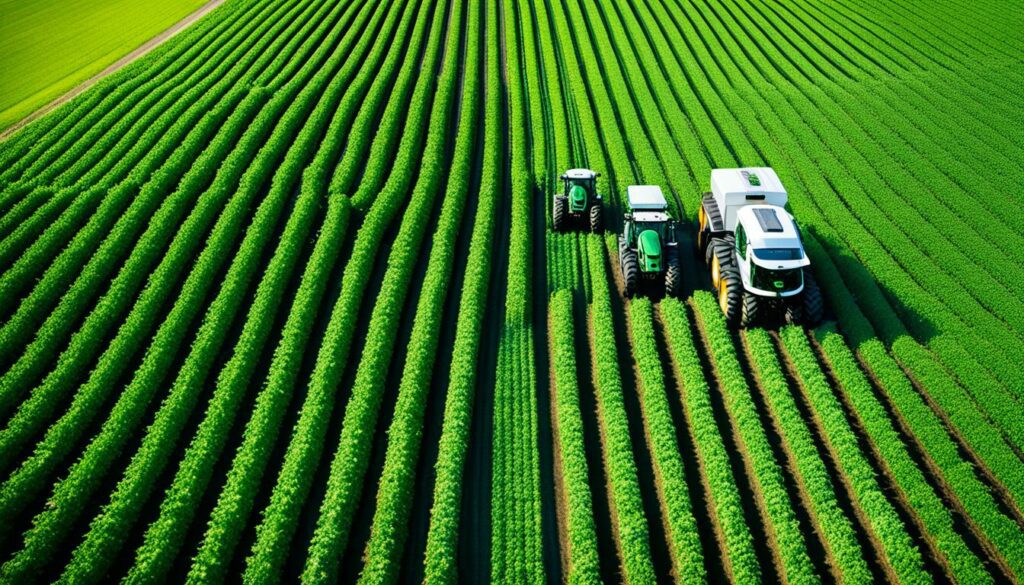
Sensors are very important in farming. They check the soil, the crops, and look at the harvest. This info helps farmers make smart choices. It also looks after the tractor to keep it working well.
Using this info on a phone or tablet is a game-changer. Adding cool cameras and AI makes the tractors smart and flexible. These tech combos are making farming better every day.
| Advantages | Examples |
|---|---|
| Increased Precision | Enhanced accuracy in planting and tilling, leading to better yields |
| Data-Driven Decision Making | Real-time analysis of soil and crop data for optimal farming practices |
| Operational Efficiency | Autonomous operation and remote monitoring capabilities |
| Safety Enhancements | Reduction in human errors and advanced obstacle detection |
Autonomous tractors are changing the game in farming. They work day and night, boosting productivity. This leads to better crop yields. They also help in using resources wisely, cutting down on waste.
Autonomous tractors stand out because they boost how much work gets done. They can work when it’s dark, so they’re always moving. This longer work time means more crops. They also solve the problem of not having enough labour by doing jobs on their own. This keeps the farm running smoothly, even with fewer workers.
| Brand | Model | Horsepower Range |
|---|---|---|
| John Deere | 8R 410 | 177-405 HP |
| New Holland | T7.315 | 302 HP |
| AGCO Fendt | 1000 Vario | 112-517 HP |
| Monarch Tractor | MK-V | Electric |
They also change the way farming precision is done. With smart sensors and real-time data, they make better farming decisions. They learn about the soil and crops to use water and fertilisers just right. This smart farming means less waste and harm to the environment.
Doing things more precisely brings more crops. By avoiding waste and covering each part of the farm well, yields go up. This careful way of managing resources makes crops healthier and more productive.
Adapting these tractors to work with other farm machines is easy. This means adding them won’t cause problems. Using this new tech makes farms work better, produce more, and get more crops out.
Autonomous tractors play a big part in making farming more sustainable. They use high-tech tools to apply fertilisers and herbicides exactly where they’re needed. This reduces the amount of chemicals that end up in the environment, harming plants and animals around us.
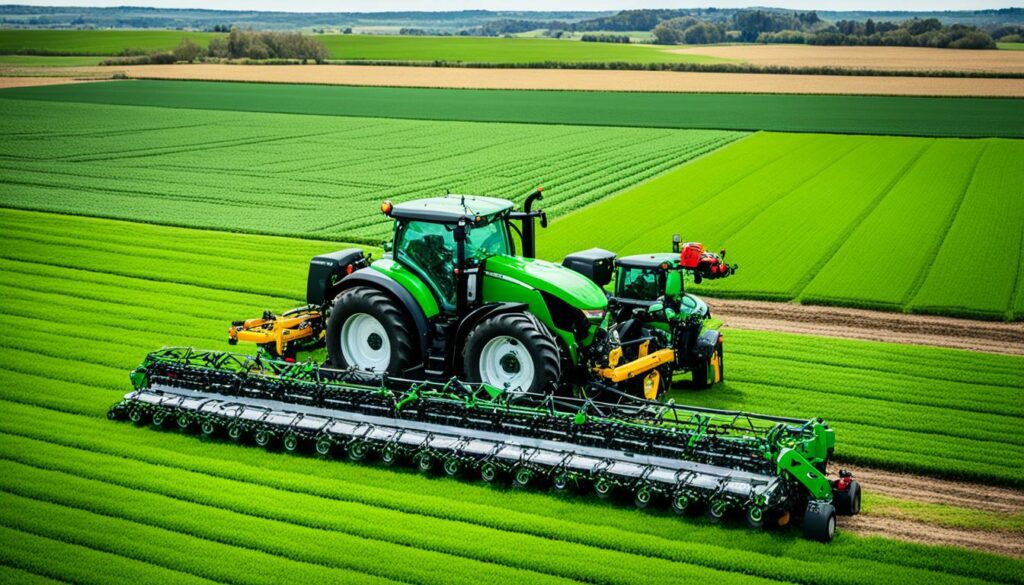
These smart machines have changed how we farm. They use up-to-the-minute data to apply just the right amount of inputs. This not only helps crops grow better but also cuts down on harmful gas emissions. There’s less waste as chemicals are used only where they’ll benefit the most.
Going green in farming is getting a boost from autonomous tractors. Vehicles like the John Deere 8R 410 and New Holland T7.315 make farms more efficient. The move towards electric, with models like the Monarch Tractor MK-V, is also a step forward. These machines help farmers make smarter choices, thanks to real-time data analysis, for a more earth-friendly approach.
Introducing autonomous tractors is a turning point in making farming less harmful to our planet. They keep farms running smoothly, use inputs better, and cut down on pollution. These changes are key for sustainable farming in the years to come.
Autonomous tractors are changing the game in farming. They help deal with the lack of workers in the field. These high-tech machines are key in tackling the ongoing labour crisis.
As farmers get older, fewer new people are joining the field. Autonomous tractors help fill the gap. They make farming easier and more efficient, even with fewer hands.
In 1928, the General Purpose Tractor let farmers do more with less effort. Today, the ITEC Pro guidance system, launched in 2008, uses advanced tech similar to self-driving cars. This technology helps with tricky vehicle manoeuvres, thanks to GPS.
One of the biggest benefits of autonomous tractors is they can work all day and night. They boost farming efforts in peak seasons without constant human oversight. This is a game-changer for modern farming.
The Monarch Tractor launched the first electric, driver-optional tractor in 2022. These tractors not only fight labour shortages but also promote protecting our planet. They’re a win for both farming needs and the environment.
| Year | Innovation | Impact |
|---|---|---|
| 1928 | General Purpose Tractor | Increased output by enabling planting and cultivating in three rows. |
| 1994 | Picture analysis system for driverless tractors | Enhanced management of miniature driverless tractors for vegetable and root crops. |
| 2008 | ITEC Pro guidance system from Deere and Company | Automated end turns and other vehicle functions using GPS technology. |
| 2022 | Monarch Tractor’s fully electric, driver-optional tractor | Flexible operation with or without a human driver, catering to diverse farming needs. |
Unmanned farm equipment is not just about doing tasks. It lets farmers take on more strategic and leadership roles. This shift is changing how farming works, for the better.
Autonomous tractors bring big savings to farms. They cut costs and save time in farming tasks. This leads to more profits for farmers. The key is in using technology to make farming more efficient.
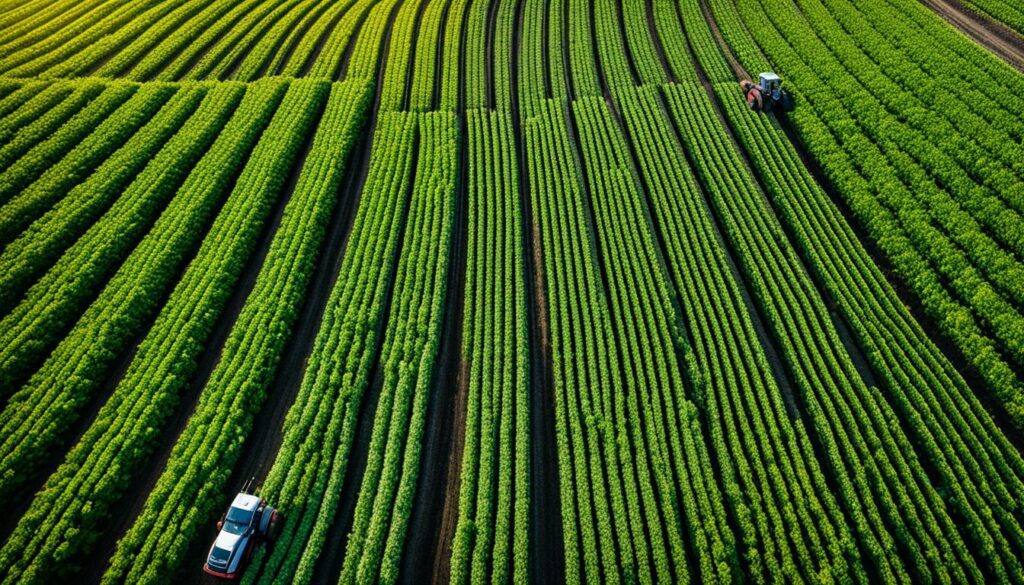
With these tractors, farms can do more with less human help. They’re very useful, especially when there’s a lot to do. This means farmers spend less money on workers but still get a lot done. It’s a win-win situation.
These smart tractors are also great at planting and spraying crops. They use just the right amount of seeds and chemicals. By using less, it’s cheaper to farm and the crops are healthier. Plus, these savings can help make food prices lower for everyone.
These tractors can work nonstop, making the farm more productive. They’re key to making farms bigger and more efficient. And, many young farmers are excited to use this new technology. This shows big potential for more farms to adopt autonomous tractors.
Adopting autonomous tractors can lead to boosting farm productivity and profits over time.
Yes, buying one of these tractors costs a lot upfront. But, the money saved later and the better farming it brings are worth it. With these tractors, farms spend less on work, fuel, and supplies. They also produce more and prices for consumers could go down.
These smart machines are changing farming for the better. They make farming more profitable and environmentally friendly than ever.
Autonomous tractors greatly boost safety on farms. They mix modern tech to cut risks and up efficiency. It’s all about making farming safer than ever before. This is a big deal as traditional farming can be very risky.
The John Deere 8R 410, for example, has stereo cameras. They spot obstacles and avoid collisions. The Yanmar’s YT5115N Prototype uses lidar and cameras to move through fields without help. This tech keeps accidents at bay on the farm.
Advanced sensors make a big difference in farming safety. The New Holland T7.315 uses lidar and radar to scan non-stop. It can make turns at the end of rows all on its own, stopping mistakes that people make. For a bad crash, tractors like the Fendt 1000 Vario shut off to avoid big harm.
New tech means a strong focus on tractor safety features. It shows the value of collision avoidance technology in farming gear. This all makes farming much safer for both machines and the people working with them. It’s a big step up in how safe farms can be.
Adopting autonomous tractors in farming is getting a big push from new technology. Smartphone connection and artificial intelligence (AI) lead the charge. They help farmers work more efficiently and easily use advanced farming tools.
Farmers can now use their phones to check on their tractors and make important decisions. This is thanks to special apps that let them keep an eye on tractor performance in real time. They get alerts instantly and can use this information to improve farm work. Using their phones in this way improves how they manage their farms.
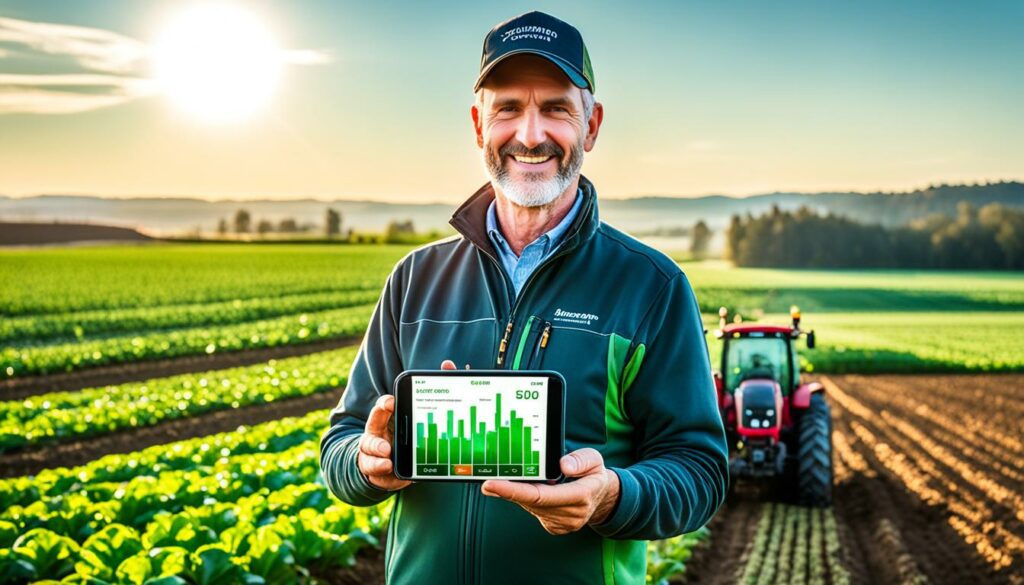
AI is a big deal in modern farming because it makes autonomous tractors super smart. These tractors can process a lot of data quickly, make predictions, and adjust to their surroundings. As a result, they work more accurately than ever before. This precision means less waste and more crops. Thanks to AI, tractors aren’t just machines. They’re like smart farm helpers.
| Tractor Model | Horsepower | Key Features | Price Range |
|---|---|---|---|
| John Deere 8R 410 Autonomous Tractor | 177 to 405 | First fully autonomous tractor sold in North America | $500,000 to $800,000 |
| CNH Industrial New Holland T7.315 | Not specified | Uses lidar and radar for obstacle detection | Not specified |
| Fendt 1000 Vario | 112 to 517 | Hands-free field navigation and slope tilling | Not specified |
| Monarch Tractor MK-V | Not specified | Fully electric, driver-optional, smart sensors | Starting at $50,000 |
| Yanmar YT5115N Prototype | Not specified | Lidar and stereo cameras for self-navigation | Undergoing refinement |
Advances in autonomous tractor technology have made farming more efficient. Yet, many farmers face challenges in adopting these new tools. They lack the necessary technical knowledge. This issue calls for specialised education to make sure these machines work smoothly.
Although farmers know a lot about farming, the tech side of autonomous tractors can be scary for them. Companies like Sabanto offer training programmes for using these machines remotely. Educating farmers on how to use technology helps them increase their farm’s productivity.
AI-powered tractor technology is not cheap. The big initial investment might stop small farms from buying these advanced systems. But, for bigger farms and cooperatives, these investments make sense in the long run. They help reduce labour shortages and boost efficiency.
But, focusing on the benefits can help reduce the cost barrier. For example, the Raven Industries’ OMNiPOWER 3200 can greatly boost productivity. Educating farmers on this, along with incentives like EV tax credits, can help cut through the cost problem.
Retrofitting existing tractors into autonomous ones can also save money. Sabanto and similar organisations are creating ways for farmers to ease into this technology without breaking the bank.
The agriculture sector is tackling real-world issues like improving connectivity. This shows a broad support for advancing agricultural technology. With everyone working together, overcoming the obstacles against autonomous tractors is becoming more achievable.
| Factors | Statistics | Impact |
|---|---|---|
| Initial Cost | High | Deters small operations |
| Farmer Education Programmes | Increasing | Reduces technical knowledge gap |
| Market Innovations | OMNiPOWER 3200, Sabanto retrofits | Demonstrates long-term savings |
The impact of autonomous tractor applications is clear. We see this through many precision farming case studies and real-world technology use in farming. These studies show how autonomous tractors can change modern agriculture. They bring advancements with smart use of technology.
TYM’s Digital Automated Vehicular Experience (D.A.V.E.) system is a big step in farming tech. The T130 tractor with D.A.V.E. boosts precision farming. It does this by finding the best work paths and cutting down on human work. Tractors with D.A.V.E. can even work in the dark, making use of each day fully.
Top sensors in these tractors check on soil and crop conditions. This helps make better decisions and get higher crop yields. Using tech like this not only makes farming more productive. It also helps the environment by using fewer harmful chemicals.

Monarch Tractor leads in innovation with its MK-V, a fully electric tractor. This beast is a benchmark in autonomous tractor use. It can farm without a driver, which is great for all farm sizes. The MK-V uses real-time data and precision to do jobs like tilling and planting perfectly.
Its efficiency improves profits without costing more. It also helps with the problem of not having enough workers by working all day and night. This makes it really useful for today’s farms.
To sum it up, real-world use of autonomous tractors is changing farming. By adopting these advances, farms can do better. They can be more efficient, better for the earth, and make more money. This tech is ensuring a bright future for farming.
| Company | Technology | Key Benefits |
|---|---|---|
| TYM | Digital Automated Vehicular Experience (D.A.V.E.) | Precision farming, year-round operation, enhanced productivity |
| Monarch Tractor | Fully electric MK-V tractor | True driverless capabilities, real-time data analysis, labour shortage solution |
The autonomous tractor industry growth is quickly changing farming. With new technology and AI, it’s moving towards smart farming. This uses AI, GPS, and modern sensors.
Its growth rate from 2020 to 2025 is set at 4.59% each year. This shows big trust in its power to change farming.
Advancements in agricultural automation help more than just productivity. They tackle the lack of farmers too. By using autonomous machines, people with skills can focus on tricky tasks that need human creativity.
Autonomous tractors are going to work all day and night, making farming more efficient. With them, farms can now produce more any time of the year.
Investing in new tech like drones and self-driving tractors will keep making farming smarter. We are already seeing quicker and more eco-friendly ways to grow food. This makes the future bright for smart farming.
Adding advanced sensors and emergency stop systems makes farms safer and more productive. Systems like the ITEC Pro guidance from Deere and Company mark the start of even better tech.
By moving towards more automation, farming will become less prone to human error. It’s heading towards being super efficient. Autonomous tractors are vital in this farming evolution, aiming for high crop yields, environmental care, and more profit.
The market for autonomous tractors worldwide is growing fast. These driverless vehicles are changing how we do farming with smart technologies. They are especially popular in North America, leading the global market.
Studies show that the desire for farming technology is pushing the use of autonomous tractors quickly. By 2028, the market for these tractors is expected to grow from USD $2.4 billion to $7.1 billion. That’s a big increase with a rate of 24.0% every year. This jump is because farms are using more advanced tools like GPS, sensors, and AI to automate work.
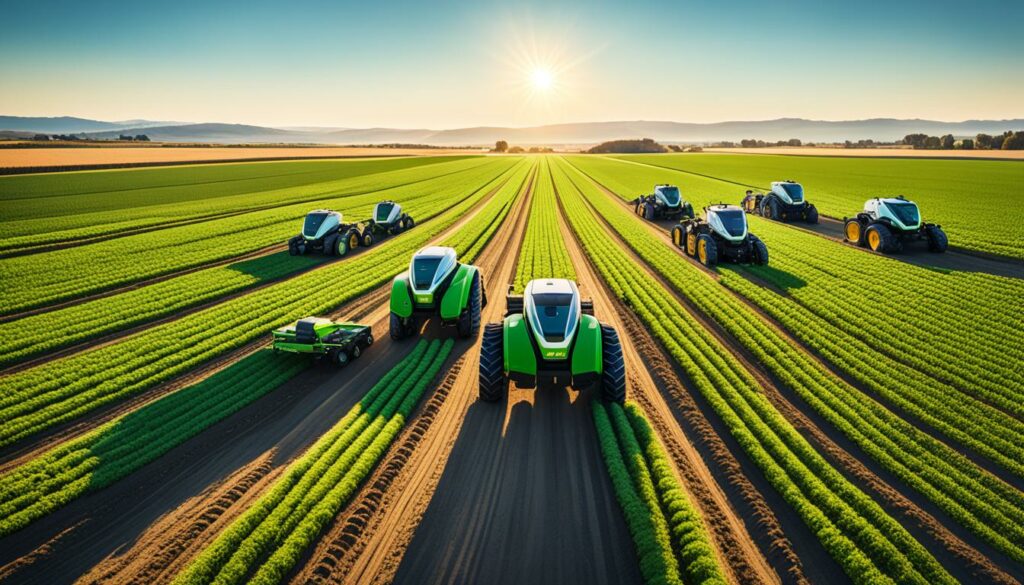
The chart below outlines the predictions for the market. It includes factors like what the machines will do on farms, how powerful they are, and what they are made of.
| Year | Farm Application (USD Million) | Power Output (‘000 Units) | Component (USD Million) |
|---|---|---|---|
| 2023 | 1,200 | 300 | 1,600 |
| 2028 | 3,550 | 850 | 5,100 |
North America is leading the way in this tech evolution, buoyed by strong support, new ideas, and the need for better farming. In 2022, a huge number of autonomous tractors were in use here. This is because the agriculture sector is quick to embrace new tech to fight labour shortages.
Focus on farming automation shows North America is doing well, and others like Europe and Asia are catching up. The push for eco-friendly food is making farming with precision a must.
Global predictions echo the trend for more autonomous tractors in farming, especially for crops like grains and vegetables. They’re key for farming better and keeping up with the world’s food needs.
In conclusion, looking at these predictions sheds light on how automation can truly change farming everywhere. It shows the big move towards autonomy in agriculture.
Autonomous tractors are changing modern farming. They are not just making things easier; they are bringing big changes. They help with not having enough workers and keeping our planet safe. Farmers can pick from different ones like the John Deere 8R 410 and the Monarch Tractor MK-V. These choices make it easier for farmers to find what suits them best.
This new way of farming is closely linked with using smart tractors. Tractors like the Fendt 1000 Vario and the CNH Industrial New Holland T7.315 have a lot to offer. They have technology like lidar and radar, helping them work better. These tractors work all the time and adjust to what’s going on around them. This makes farming more precise and saves money on workers.
Autonomous tractors are also helping to farm in a greener way by using the land better and using fewer chemicals. Tractors like the Yanmar YT5115N Prototype are leading the way by being cab-less. This is better for the earth. These tractors can also collect data to help plan the best ways to grow food in the future. Young people find this exciting. It’s making farming a field full of new ideas and changes, ready for the future.
As tech gets better, these smart tractors will play a bigger part in farming. They are not just about working faster; they are safer and cost less. These machines show how farming can be good for the planet. They are a big step towards farming that is both smart and kind to the earth. This is how we will make food for the coming years, making a big difference.
Autonomous tractors are farm machines that don’t need a driver. They use GPS and sensors. This tech lets them do farming jobs without much help. This makes farm work more precise and automated.
This type of tractor has special parts to work alone. These include systems to help with driving, tools that use GPS to be very accurate, smart tractor tech, and lots of sensors. These all work together.
GPS lets tractors know exactly where they are. This is key for tasks like planting and spraying. Advances in GPS make farming more precise.
Sensors give tractors updates on the soil, plant health, and how the tractor is doing. This data helps in using resources more wisely. It also boosts how precise farming is.
These tractors help farms run better and faster, day and night. They make farming more exact. This raises the amount of crops. They also save a lot of money on fuel and resources.
These tractors use just the right amount of chemicals. This way, they pollute less. They also help farms be more sustainable, which cuts down on harmful emissions.
Autonomous tractors work all the time, needing less human help. This is great, especially when farms are busiest.
They will save a lot of money on time, fuel, and materials. This makes farming more profitable. investing in this tech can bring in big returns.
They come with smart safety tech to avoid crashes and alert about dangers. This keeps the people running them safe.
Farmers can use their phones to check on the tractors and make choices based on data. This means managing the tractors from anywhere.
AI helps these tractors learn and respond to changes. It analyses a lot of data, making the tractors work better and smarter.
Some farmers may not know how to use this technology. The cost can be a challenge too. There’s a need for more training to help spread the tech.
TYM’s D.A.V.E. system with the T130 tractor shows how well these tractors can work. They pick the best routes and help farms stay green by farming with great precision.
Technologies like AI, sensors, and going electric will make these tractors a big part of farming’s future. They’ll make farming more efficient, productive, and eco-friendly.
The market for these tractors is growing fast. By 2028, it could be worth .1 billion. This growth is fueled by the need for better farming everywhere. Tech is getting more and more important.